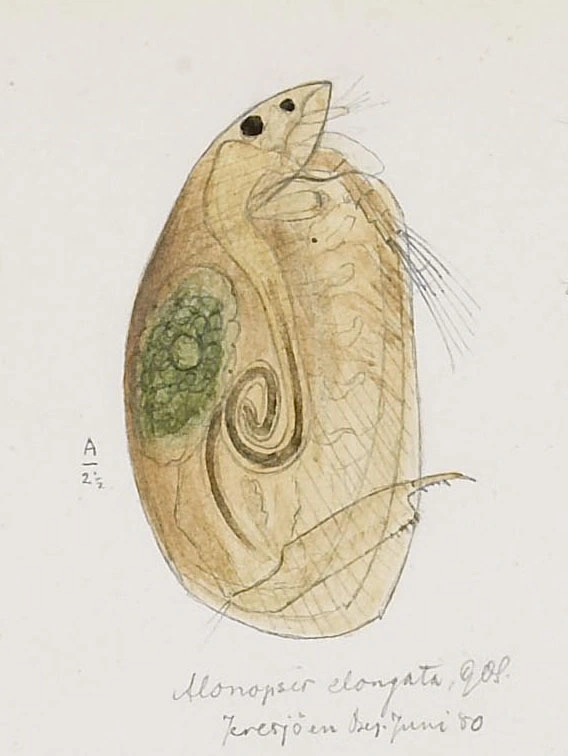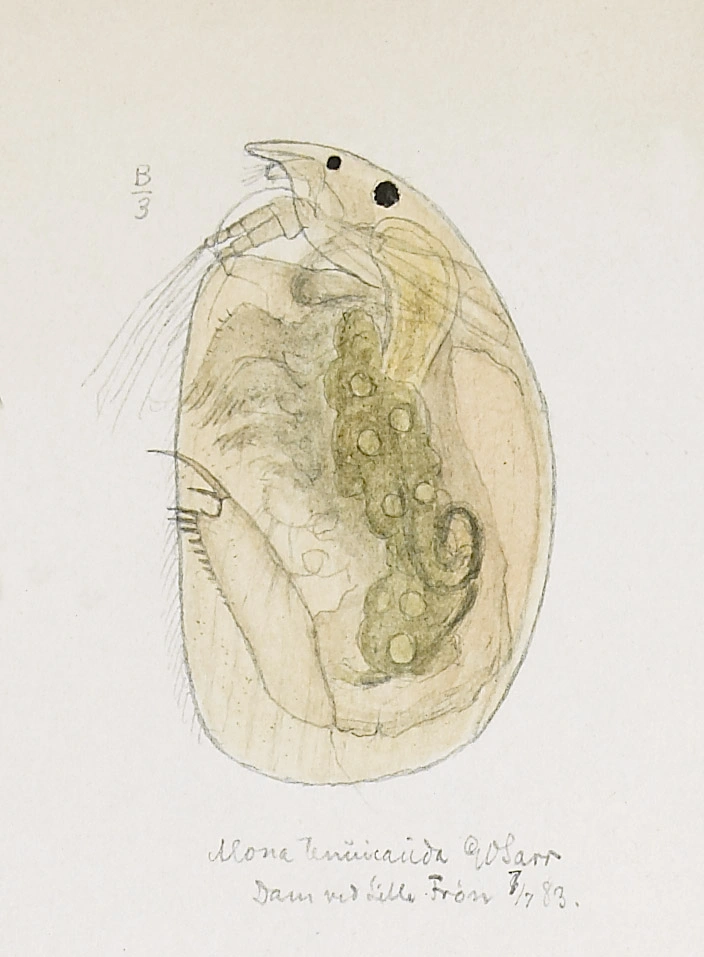Alonopsis elongata
Alonopsis elongata is one of the most common littoral species in Norway and is associated with electrolyte poor water. It may have many layers of old shields, which gives it a coffee brown look.
Key characteristics
Alonopsis elongata (female)
Alonopsis elongata shows similarities to Acroperus harpae, however its carapace has a more rectangular form with the maximum height in the posterior part. It has a short rostrum with both eyes situated near the front of the head shield. There are 15–17 teeth on the postabdomen decreasing in size proximally. The arrangement of bristles on the abdominal claw also distinguishes this species from A. harpae. It may have many layers of old shields, which gives it a coffee brown look.
Female: Length 1.0 mm
Male: Length 0.6–0.7 mm
Ecology and distribution
A. elongata is one of the most common littoral species and occurs in 73 % of the water bodies in all parts of Norway. Among cladocerans only B. longispina is more common. A. elongata is found from sea level to 1500 m a.s.l. It occurs with a slightly higher frequency in localities above 500 m a.s.l. than below this altitude. It is more common in lakes (80 %) than in ditches and small ponds (36 %). It occurs in waters of different pH, varying from 3.9 to 8.2, with its highest frequency at pH between 4.5 and 6.0. A. elongata is slightly more common in electrolyte poor water than in electrolyte rich water.
| Vitenskapelig navn | < 4,5 | 4,5 - 4,9 | 5,0 - 5,4 | 5,5 - 5,9 | 6,0 - 6,4 | 6,5 - 7,0 | 7,0 - 7,4 | > 7,5 |
|---|---|---|---|---|---|---|---|---|
| 51 | 92,2 | 89,5 | 76,8 | 70,4 | 66,4 | 53,3 | 28,6 |
| Vitenskapelig navn | < 1,0 | 1,0 - 1,4 | 1,5 - 1,9 | 2,0 - 2,9 | 3,0 - 3,9 | 4,0 - 4,9 | 5,0 - 6,9 | 7,0 - 9,9 | > 10,0 |
|---|---|---|---|---|---|---|---|---|---|
| 82,2 | 85 | 76,4 | 74,2 | 77,8 | 66 | 64,1 | 44,4 | 25,6 |
| Vitenskapelig navn | < 0,01 | 0,01 - 0,09 | 0,1 - 0,9 | 1,0 - 9,9 | 10,0 - 99 | 100 - 999 | > 1000 |
|---|---|---|---|---|---|---|---|
| 21,6 | 28,9 | 57,9 | 72,6 | 79,9 | 84,4 | 87 |
| Vitenskapelig navn | < 100 | 100-299 | 300-499 | 500-699 | 700-999 | >1000 |
|---|---|---|---|---|---|---|
| 63 | 60,2 | 73,6 | 77,1 | 86,7 | 70,8 |
Look-alikes
Acroperus harpae and Oxyurella tenuicaudis


